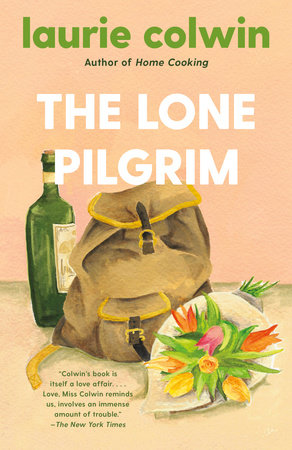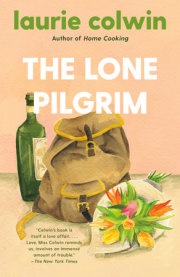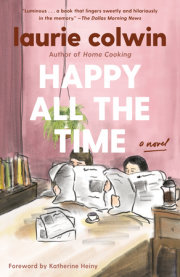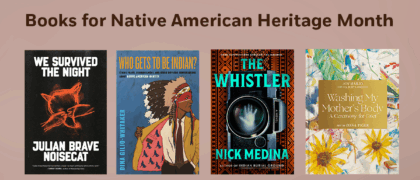Chapter 1
The Lone Pilgrim
I have been the house pet to several families: friendly, cheerful, good with children, and, most important, I have an acute sensitivity to the individual rhythms of family life. I blend in perfectly, without losing myself. A good houseguest is like an entertainer: Judy Garland, Alfred Hitchcock, Noel Coward. You know what a specific public wants—in my case, groups of two, with children.
For example, Paul and Vera Martin and their children, Ben and Violet. Paul and Vera are lawyers. Paul spends rainy Sundays fishing, and although Vera is a good cook, she is not fond of cleaning fish, so Paul’s grandfather’s knife is entrusted to me. I do the neat job of a surgeon. Vera, who likes precision, was so impressed by my initial performance that she allowed me into her kitchen, and we have been cooking together ever since. I knew by instinct where she would keep her pots, her baking dishes, her mixing bowls, her silverware. If you are interested in people, their domestic arrangements are of interest, too. That’s the sort of student of human conduct I am.
In Maine, I visit Christopher and Jean Goodison and their little son, Jean Luc. The Goodisons are haphazard housekeepers, but I have their routine down pat. Their baby and I get along famously. We have a few moments together: a hailstorm he observed from my lap; a lesson in crawling; an afternoon with a kitten. The best way with babies, I have come to know, is quietude. Never approach first. Be casual. Pay minimal tactile attention, and never try to make them love you. You can sit on the same sofa with a child and do nothing more than clutch its little foot from time to time, and before long you will have that child on your lap.
The Goodisons will leave Jean Luc with me when they go shopping, although ordinarily—with ordinary mortals, that is—they are very protective of their son. When they return, I surprise them with a Lady Baltimore cake. Alone in their house, I admire their Shaker table, the fancy-back spoons I find mixed in with their spatulas, the dried-flower arrangements in their lusterware pitchers.
And there are others: the Hartwells in Boston, who live in a Spartan apartment decorated with city-planning charts. The rigorous Mazzinas, who take me camping. The Jerricks, who dress for dinner and bring you a breakfast tray on Sunday morning: coffee, toast, and a small vase with a single flower in it. My friends admire my charm, my sagacity, my propriety, and my positive talent for fitting in with the daily life of others while holding my own.
The adhesive tape on my mailbox reads “P. Rice.” Paula Rice, that is, known to all as Polly. I am the charming girl illustrator. I did the pictures for Hector the Hero, The Pig Who Said Pneu, Fish with Feathers, Snow White and Rose Red, and The I Don’t Care Papers—all children’s books. Five feet four, reddish hair, brown eyes, long legs. At college, I studied medieval French literature, but kept a sketchbook with me at all times. During the summers, I studied calligraphy, papermaking, and bookbinding, and worked as an apprentice at the Lafayette Press, printers of fine editions. I make a living illustrating children’s books, but to please myself I do etchings and ink drawings, which I often present to friends on special occasions—marriages, anniversaries, birthdays.
On the side, I am a perfect houseguest. I have the temperament for it. Being a designer teaches you the habit of neatness, and an appreciation for a sense of order not your own. Being a houseguest allows you to fantasize with no one crowding you. After all, you are but a guest, an adornment. Your object is to give pleasure to your hosts. Lolling around in other people’s houses allows your mind to drift. Inspired by my surroundings, I indulge myself in this lazy, scene-setting kind of thought. For example: a big yellow moon; the kitchen of an old house in an academic community. On the window ledge a jar of homemade jam, a pot of chives, a cutting of grape ivy in a cracked mug. A big dog sleeps in front of the stove. If you open the window, you feel the crisp October air. An apple pie or a loaf of bread is in the oven, and the house is warm with the scent of it. You wonder if it is time to deal with the last pumpkin, or to pickle the basket of green tomatoes. In the study, your husband is drowsing over an elevating book, a university-press book in blue wrappers. You are wearing a corduroy skirt, a chic blouse, and a sweater of your husband’s is tied around your shoulders. You are a woman contemplating seasonal change.
Or you go to the Martins on a rainy night. They occupy two floors of a Victorian brownstone, and as you contemplate the polished moldings and watch the rain through the leaded windows, you feel you are in England in the spring—in a little house in Devizes, say, or Bexhill-on-Sea. Your children have just been put to bed. You have finished reading a book on the life of Joseph Wright of Derby. There is a knock on the door. You start up. Your husband is away, and it is foggy outside. At the door is an old lover, someone who broke your heart, who is in England on business and has tracked you down.
Of course, the fact of the matter is that you live in a flat in New York. Your work is done at an oak drawing table, surrounded by pots of brushes and pens. In other people’s houses your perspective widens. You contemplate the Martins’ old Spode platter. You know the burn on their dining-room table—the only flaw in its walnut surface—is from Paul’s cigar, placed there the night before Ben was born. These details feed the imagination.
Oh, domesticity! The wonder of dinner plates and cream pitchers. You know your friends by their ornaments. You want everything. If Mrs. A. has her mama’s old jelly mold, you want one, too, and everything that goes with it—the family, the tradition, the years of having jelly molded in it. We domestic sensualists live in a state of longing, no matter how comfortable our own places are.
You cannot be a good houseguest and be married. Single, you carry only the uncluttered luggage of your own personality, selected and packed by only one pair of hands. Marriage is two-dimensional to the unmarried. No matter how close they get to a couple, they view the situation without any depth perception. If companionship is what you want, and you don’t have it, any part of it looks good, including complaints, squabbles, misunderstandings. If only, you feel, you had someone close enough to misunderstand. Intimate enough to squabble with. Well known enough to complain about. Marriage is a condition, like neatness, or order. It is as safe as the wedding silver on the sideboard. To the unmarried, marriage is a sort of trapping, right down to the thin, unobtrusive gold bands.
That’s romanticism for you. No one fantasizes about dreary afternoons, despair, unreasonableness, chaos, and boredom. Not the unmarried, that is—especially if they contemplate marriage from a perch of well-savored solitude. Solitude provides you the luxury of thinking about the closed, graceful shapes of other people’s lives. My friends are steady, just like me. But, steady as I am, why am I so solitary? No matter how orderly, measured, and careful my arrangements are, they are only a distillation of me, not a fusion of myself and someone else. I have my domestic comforts, except that mine are only mine.
My life changed with the appearance into it of Gilbert Seigh. It was for Gilbert that I produced my best work: illustrations for The Art of Courtly Love and The Poems of Marie de France.
Gilbert’s father, grandfather, and great-grandfather had been publishers of fine editions. After practicing law for five years, Gilbert took over the business when his father’s eyesight began to fail. Gilbert was born into the business and was infected with it. His great-grandfather did editions of James Fenimore Cooper, Thackeray, and Mrs. Scott Courrier-Maynard, a now unknown poet of Connecticut. His grandfather went in for U. S. Grant’s memoirs, Washington Irving, and speeches of American presidents. Gilbert’s father did the poets of his day, edited and published a little magazine called Lampfire, and produced double-language volumes of Rimbaud, Rilke, and Christian Morgenstern. Gilbert goes in for the classics, for naturalist works, and for Melville. Three thousand dollars will get you the Seigh Press edition of “Billy Budd.” Six will get you his two volumes of Wild Flowers of the North American Continent.
Gilbert does not look like a man of books. He looks like a young auto magnate: large, ruddy, and enthusiastic. His glasses fog over from sheer enjoyment. He has a hot temper and a big, loud laugh. I often picture him in his leather chair at his office, laughing and wiping his glasses on the vest of his woolly suit. I like to watch him go up against his master binder, a fiery Italian named Antonio Nello, fighting about the ornaments for a spine. This clash of hardheaded perfectionists brings forth stubborn shouting from Gilbert and operatic flights of invective from Antonio, after which the correct solution is reached.
Several months after I met Gilbert, I fell in love with him. I was sent to him by Paul Martin. Gilbert, at dinner with Paul and Vera, had said he was looking for an illustrator and couldn’t find one whose work he liked. He had been to dozens of galleries, museums, and agents. He had looked through hundreds of illustrated books. Then Paul showed him a drawing I had done to celebrate the birth of Violet. It shows a homely little girl sitting in a field of lavender and purple flowers. Gilbert asked if the artist was still alive. It was the best thing he had seen since Arthur Rackham, he said. Vera produced copies of Fish with Feathers and Snow White and Rose Red. Thus the girl illustrator met Gilbert Seigh one rainy midmorning. He skimmed through my portfolio, and since there was nothing at stake, I felt free to dislike him. I felt he was cavalier with my work. I felt I had been set up by the Martins to meet an available man whose tastes were similar to my own. He closed the portfolio and began to hum happily, at which point I figured him for a moron.
“ ‘My heart is like a singing bird,’ ” he sang.
My reactions were coming thick and fast now. I thought he was arrogant, insolent, pretentious, and unattractively eccentric. I picked up the portfolio and tied its ribbons.
I said, “Thank you for seeing me,” and began to leave.
“Oh, wait,” he said. “I’ve put you off. I’m terribly sorry. You think I haven’t paid proper attention to your work, but I already know your work. Vera showed me your books and the picture you did for Violet. I was behaving like a fool because it’s so good. I’m too mono-minded to have told you. You’re the illustrator I’ve been looking for. Please sit down.”
I sat. I thought he was cuckoo. Then he described the project he had in mind: an edition of Andreas Capellanus’s The Art of Courtly Love. I told him I had studied medieval literature. He glowed with delight, and wiped his glasses. He still seemed a little batty to me, but he certainly knew what beautiful books were all about.
That’s how it began. I went home, finished my last assignment, and began doing my best work for Gilbert Seigh.
We worked elegantly together. It was a perfect match. He took me out to lunch often, and never so much as brushed my arm with his sleeve. It was said he had been keeping company with a lady lawyer, who had been more or less a fixture in his life since his divorce. So it was to Gilbert that I dedicated my heart. I brooded about him constantly. Being in love with him brought me all the things in life I counted on: a sense of longing, something to turn over and over in my mind, and that clear, slightly manic vision you get with unrequited love. Each line I drew was a dedication of sorts. Choosing type, browsing through books of paper samples, planning and designing, going over proofs with him, gave me an extreme sense of heady pleasure. If that wasn’t love, what was?
Well, I’ll tell you what was. I had suffered in love three years before, and it had not stopped haunting me. The man in question was an astronomer by the name of Jacob Bailey. Somewhere in the heavens is a galaxy named for him: the Bailey galaxy. It can only be seen through an observatory telescope—he showed it to me once at an observatory in Vermont. I will probably never see it again. I met Jacob in the line of work—the way I felt it was proper to meet those with whom you will have a profound connection. I was doing the drawings for a children’s book on Kepler, and Jacob was checking the text and pictures for accuracy. It was love at once—hot, intense, brilliant, and doomed to fail. When it did, and we parted, it was with much puzzlement and despair. Jacob wanted a grand event—something you would never forget but not something to live with. I wanted something to live with. A love affair conducted with the same thrilling rev-up that starts a Grand Prix race usually runs its course and stops. When the Rice and Bailey show was over, I went into a form of mourning. I felt that being crossed in love had changed me, and it had, but my life stayed the same. I worked with what I felt was new depth, and carried Jacob around as a secret in my heart.
When you fall in love like that, it strikes like a disease, and you can understand why nineteenth-century poets felt they were either sick with love or dying of it. Divorced people sometimes remember the joys of married life as strains, but in a love affair just the reverse is true. Since marriages are final and love affairs are open-ended, you tend to think about what might have been instead of what was. So I recalled Jacob’s gorgeous smile but not his cruel streak. I remembered the resemblance I thought he bore to an angel but not his frequent nastiness and its effect. But what difference does it make? I remembered. My life—my inner life—became a kind of reverie, and it would not have shocked me had I found that in some dreamlike state I had created a little shrine to Jacob Bailey: his photograph, my book on Kepler, a parking ticket from the Bronx Zoo, the little pearl earrings he gave me. The idea of committed, settled love is as remote to a romantic as lunar soil.
Copyright © 2021 by Laurie Colwin. All rights reserved. No part of this excerpt may be reproduced or reprinted without permission in writing from the publisher.







